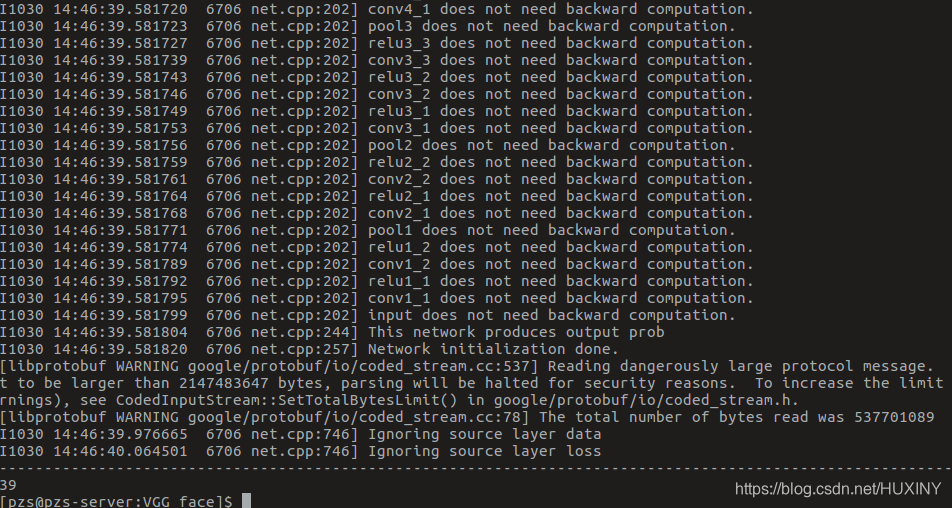VGG_face Caffe 微調(finetuing)詳細教程(二)
阿新 • • 發佈:2018-12-18
引言
接著上篇文章,我們瞭解瞭如何在vgg_face模型的基礎上進行微調。接下來我將介紹如何使用微調好的模型識別人臉。
一.deploy配置檔案
在使用模型之前還需要一個deploy.prototxt,該檔案儲存的是神經網路的結構,和train_test.prototxt有什麼不同?train_test.prototxt是訓練時用的網路結構,deploy.prototxt是生產環境所用的網路結構,兩個網路的頭和尾有些不同,中間結構是相同的。
建立一個deploy.prototxt檔案,可直接copy下面程式碼:
name: "VGG_FACE_16_Net" input: "data" input_dim: 1 input_dim: 3 input_dim: 224 input_dim: 224 force_backward: true layer { name: "conv1_1" type: "Convolution" bottom: "data" top: "conv1_1" convolution_param { num_output: 64 kernel_size: 3 pad: 1 } } layer { name: "relu1_1" type: "ReLU" bottom: "conv1_1" top: "conv1_1" } layer { name: "conv1_2" type: "Convolution" bottom: "conv1_1" top: "conv1_2" convolution_param { num_output: 64 kernel_size: 3 pad: 1 } } layer { name: "relu1_2" type: "ReLU" bottom: "conv1_2" top: "conv1_2" } layer { name: "pool1" type: "Pooling" bottom: "conv1_2" top: "pool1" pooling_param { pool: MAX kernel_size: 2 stride: 2 } } layer { name: "conv2_1" type: "Convolution" bottom: "pool1" top: "conv2_1" convolution_param { num_output: 128 kernel_size: 3 pad: 1 } } layer { name: "relu2_1" type: "ReLU" bottom: "conv2_1" top: "conv2_1" } layer { name: "conv2_2" type: "Convolution" bottom: "conv2_1" top: "conv2_2" convolution_param { num_output: 128 kernel_size: 3 pad: 1 } } layer { name: "relu2_2" type: "ReLU" bottom: "conv2_2" top: "conv2_2" } layer { name: "pool2" type: "Pooling" bottom: "conv2_2" top: "pool2" pooling_param { pool: MAX kernel_size: 2 stride: 2 } } layer { name: "conv3_1" type: "Convolution" bottom: "pool2" top: "conv3_1" convolution_param { num_output: 256 kernel_size: 3 pad: 1 } } layer { name: "relu3_1" type: "ReLU" bottom: "conv3_1" top: "conv3_1" } layer { name: "conv3_2" type: "Convolution" bottom: "conv3_1" top: "conv3_2" convolution_param { num_output: 256 kernel_size: 3 pad: 1 } } layer { name: "relu3_2" type: "ReLU" bottom: "conv3_2" top: "conv3_2" } layer { name: "conv3_3" type: "Convolution" bottom: "conv3_2" top: "conv3_3" convolution_param { num_output: 256 kernel_size: 3 pad: 1 } } layer { name: "relu3_3" type: "ReLU" bottom: "conv3_3" top: "conv3_3" } layer { name: "pool3" type: "Pooling" bottom: "conv3_3" top: "pool3" pooling_param { pool: MAX kernel_size: 2 stride: 2 } } layer { name: "conv4_1" type: "Convolution" bottom: "pool3" top: "conv4_1" convolution_param { num_output: 512 kernel_size: 3 pad: 1 } } layer { name: "relu4_1" type: "ReLU" bottom: "conv4_1" top: "conv4_1" } layer { name: "conv4_2" type: "Convolution" bottom: "conv4_1" top: "conv4_2" convolution_param { num_output: 512 kernel_size: 3 pad: 1 } } layer { name: "relu4_2" type: "ReLU" bottom: "conv4_2" top: "conv4_2" } layer { name: "conv4_3" type: "Convolution" bottom: "conv4_2" top: "conv4_3" convolution_param { num_output: 512 kernel_size: 3 pad: 1 } } layer { name: "relu4_3" type: "ReLU" bottom: "conv4_3" top: "conv4_3" } layer { name: "pool4" type: "Pooling" bottom: "conv4_3" top: "pool4" pooling_param { pool: MAX kernel_size: 2 stride: 2 } } layer { name: "conv5_1" type: "Convolution" bottom: "pool4" top: "conv5_1" convolution_param { num_output: 512 kernel_size: 3 pad: 1 } } layer { name: "relu5_1" type: "ReLU" bottom: "conv5_1" top: "conv5_1" } layer { name: "conv5_2" type: "Convolution" bottom: "conv5_1" top: "conv5_2" convolution_param { num_output: 512 kernel_size: 3 pad: 1 } } layer { name: "relu5_2" type: "ReLU" bottom: "conv5_2" top: "conv5_2" } layer { name: "conv5_3" type: "Convolution" bottom: "conv5_2" top: "conv5_3" convolution_param { num_output: 512 kernel_size: 3 pad: 1 } } layer { name: "relu5_3" type: "ReLU" bottom: "conv5_3" top: "conv5_3" } layer { name: "pool5" type: "Pooling" bottom: "conv5_3" top: "pool5" pooling_param { pool: MAX kernel_size: 2 stride: 2 } } layer { name: "fc6" type: "InnerProduct" bottom: "pool5" top: "fc6" inner_product_param { num_output: 4096 } } layer { name: "relu6" type: "ReLU" bottom: "fc6" top: "fc6" } layer { name: "drop6" type: "Dropout" bottom: "fc6" top: "fc6" dropout_param { dropout_ratio: 0.5 } } layer { name: "fc7" type: "InnerProduct" bottom: "fc6" top: "fc7" # Note that lr_mult can be set to 0 to disable any fine-tuning of this, and any other, layer inner_product_param { num_output: 4096 } } layer { name: "relu7" type: "ReLU" bottom: "fc7" top: "fc7" } layer { name: "drop7" type: "Dropout" bottom: "fc7" top: "fc7" dropout_param { dropout_ratio: 0.5 } } layer { name: "fc8_flickr" type: "InnerProduct" bottom: "fc7" top: "fc8_flickr" # lr_mult is set to higher than for other layers, because this layer is starting from random while the others are already trained propagate_down: false inner_product_param { num_output: 200 # 改,有多少類別就改為多少,根據上篇文章,這裡改為40 } } layer { name: "prob" type: "Softmax" bottom: "fc8_flickr" top: "prob" }
二.python指令碼使用模型
不多說,直接上程式碼:
import caffe deployFile = '/home/pzs/husin/caffePython/husin_download/VGG_face/deploy.prototxt' modelFile = '/home/pzs/husin/caffePython/husin_download/VGG_face/snapshot/solver_iter_1000.caffemodel' imgPath = '/home/pzs/husin/caffePython/husin_download/VGG_face/val/40-5m.jpg' # 這裡我選擇的人臉是40-5m.jpg,讀者可以任意選擇 def predictImg(net,imgPath): # 得到data的形狀,這裡的圖片是預設matplotlib底層載入的 # matplotlib載入的image是畫素[0-1],圖片的資料格式[weight,high,channels],RGB # caffe載入的圖片需要的是[0-255]畫素,資料格式[channels,weight,high],BGR,那麼就需要轉換 transformer = caffe.io.Transformer({'data':net.blobs['data'].data.shape}) transformer.set_transpose('data',(2,0,1)) # 改成[channels,weight,high] transformer.set_raw_scale('data',255) # 畫素區間擴充套件為[0,255] transformer.set_channel_swap('data',(2,1,0)) # RGB im = caffe.io.load_image(imgPath) # 載入圖片 net.blobs['data'].data[...] = transformer.preprocess('data',im) # 用上面的transformer.preprocess來處理剛剛載入圖片 output = net.forward() # 進行前向傳播 output_prob = output['prob'][0] # 最終的結果: 當前這個圖片的屬於哪個物體的概率(列表表示) print '---------------------------------------------------------------------------------------------------------------------' print str(output_prob.argmax()) # 輸出概率最大的標籤 if __name__=='__main__': net = caffe.Net(deployFile,modelFile,caffe.TEST) predictImg(net,imgPath)
三 . 執行結果
這裡我檢測的是val/40-5m.jpg, 所屬類應該是39(因為從0開始), 下面是輸出結果:

可以看到,檢測很準確,讀者可以試試其他的人臉,我這裡試過,都是準確的。
結束語
該文章是本人對caffe學習的階段總結,有錯誤之處還請大家指出,以共同學習。
And let us not be weary in well-doing, for in due season, we shall reap, if we faint not
